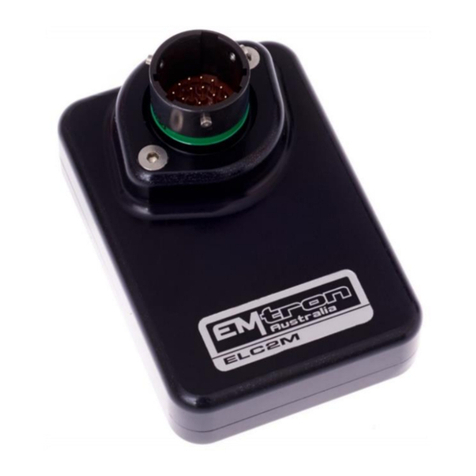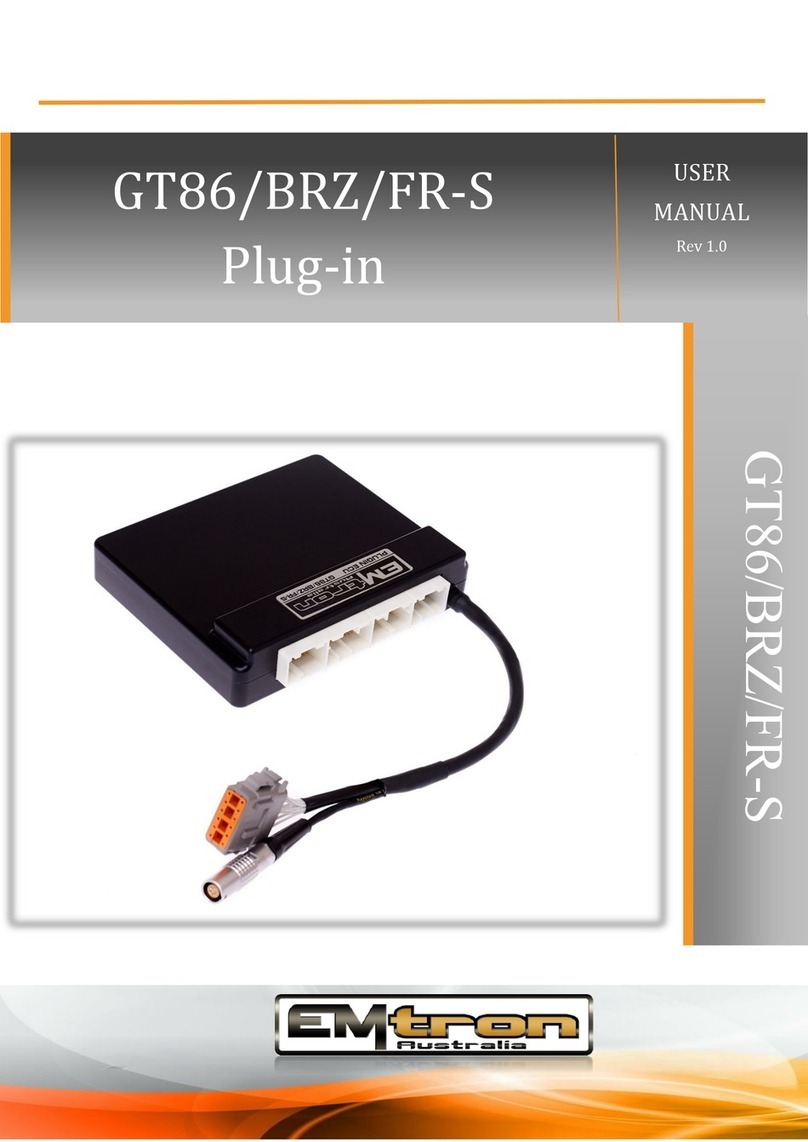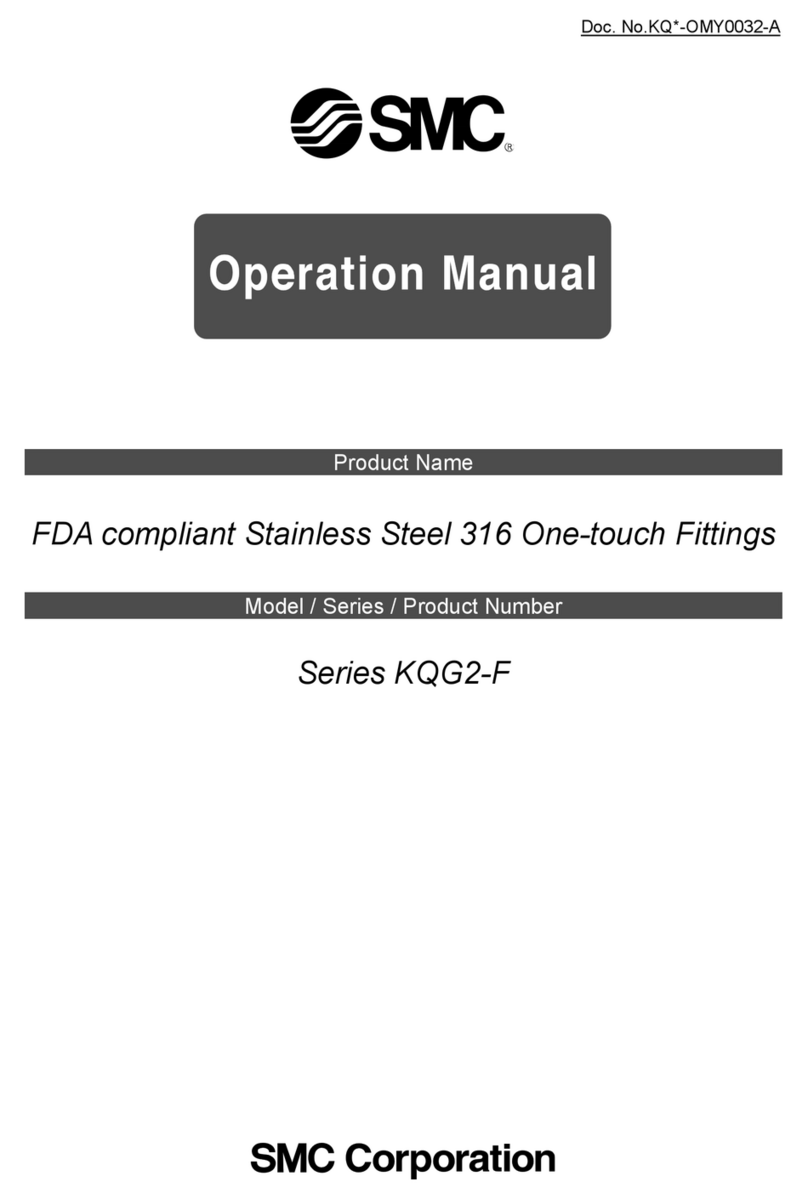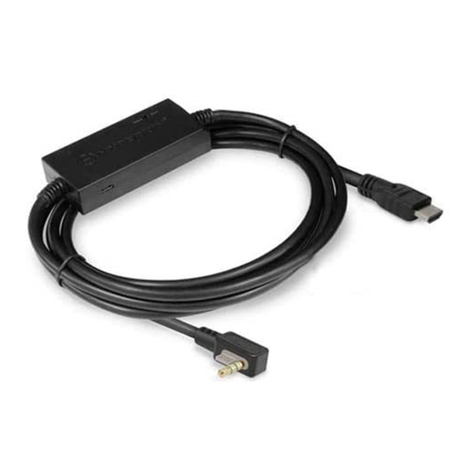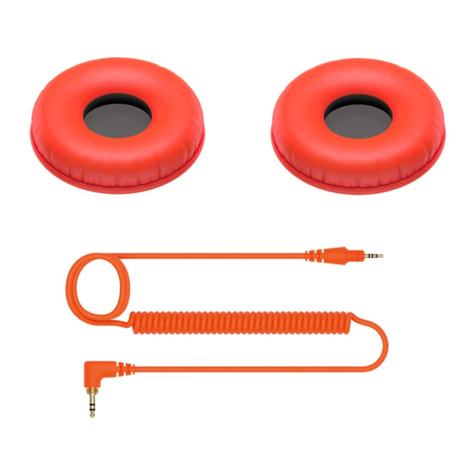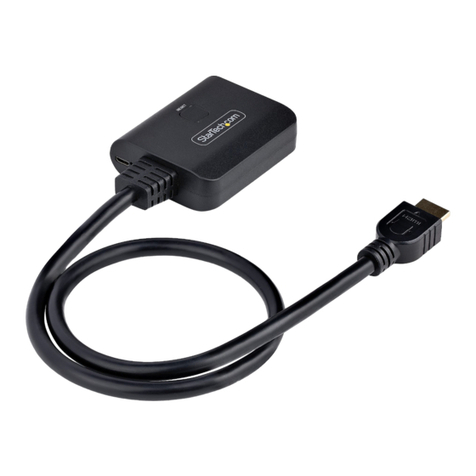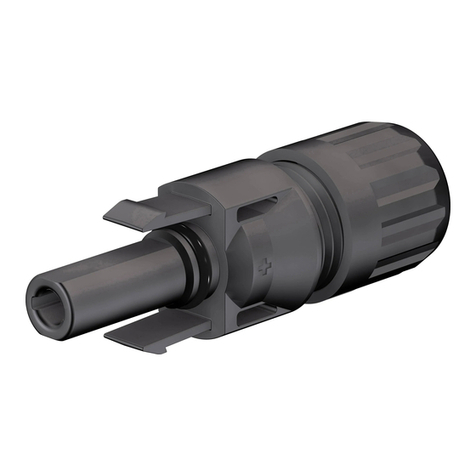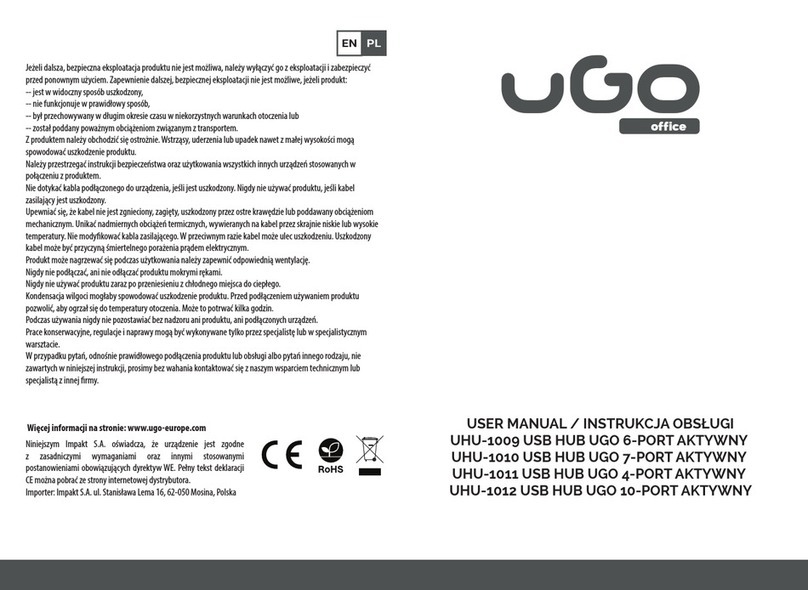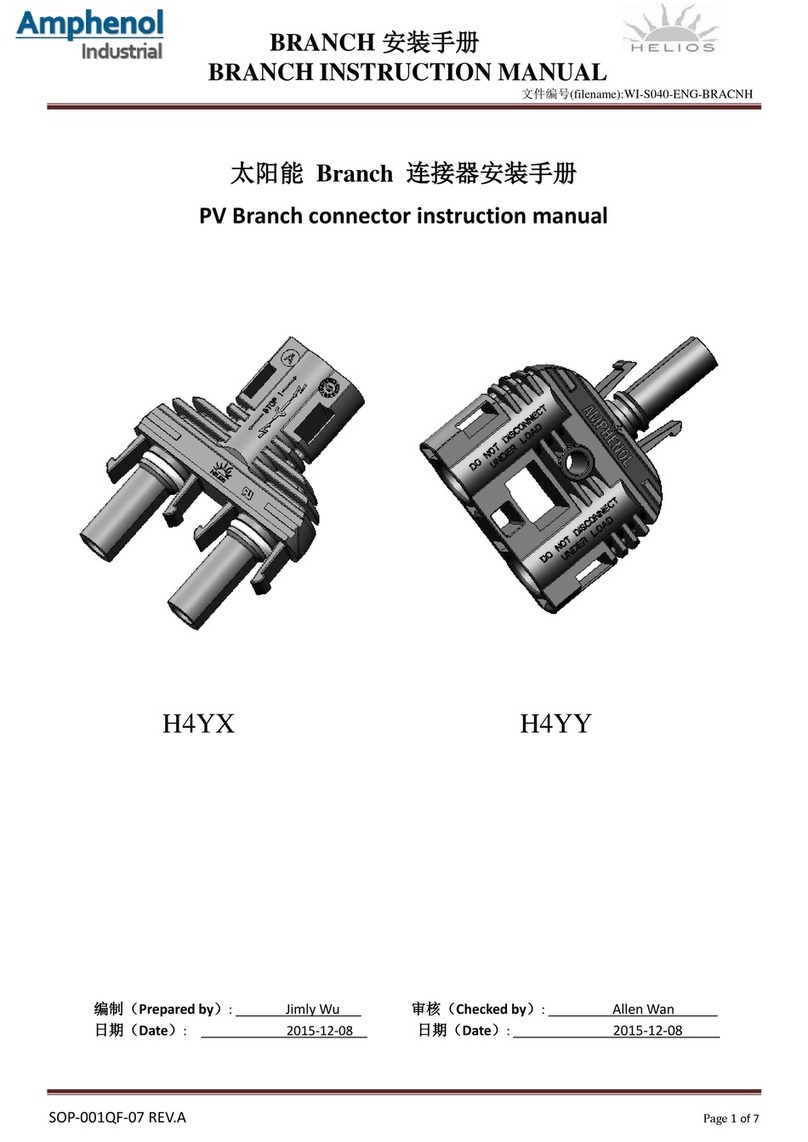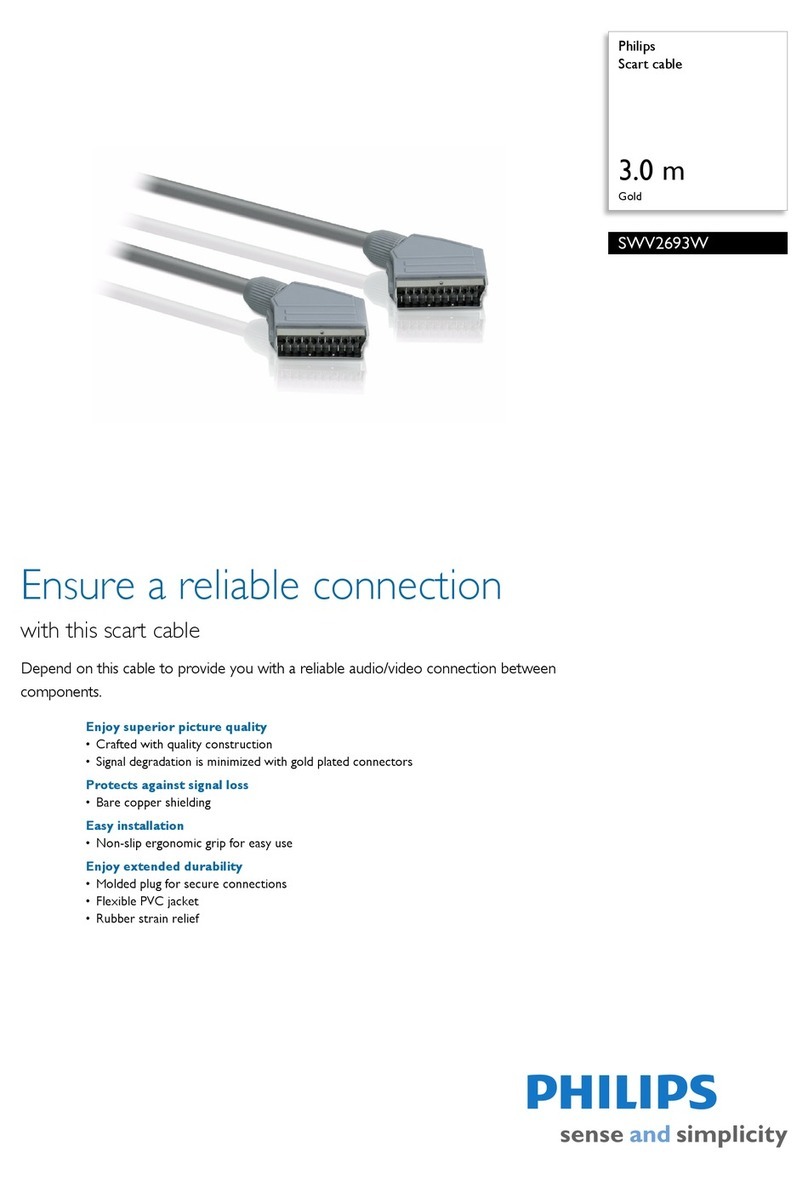Emtron EIC10 User manual

Z
EIC10/ EIC16M
USER
MANUAL
Rev 1.0
Emtron Input
Expansion to CAN

EMTRON EIC USER MANUAL
WWW.EMTRON.WORLD
© EMTRON AUSTRALIA PTY LTD APRIL 2018
1
Kit Contents
When purchasing an EIC10 the following items are included:
▪EIC10 Device with Flying Harness
▪Deustch DTM 4-way connector and female pins (DTM06-4S)
▪Deustch DTM 12-way connector and male pins (DTM04-12PA)
EIC10 kit pictured.
When purchasing an EIC16M the loom side mating Autosport connector is not included but
can be purchased separately.

EMTRON EIC USER MANUAL
WWW.EMTRON.WORLD
© EMTRON AUSTRALIA PTY LTD APRIL 2018
2
Contents
1.0 Description ...........................................................................................................................3
2.0 Specification.........................................................................................................................4
3.0 Installation ...........................................................................................................................6
3.1 EIC10 Pinout.....................................................................................................................6
3.2 EIC16M Pinout .................................................................................................................7
3.3 CAN Bus............................................................................................................................8
3.4 Pullup Resistors................................................................................................................9
3.5 Frequency Inputs ...........................................................................................................10
3.6 Noise Immunity..............................................................................................................11
3.7 Sensor Wiring.................................................................................................................11
3.8 CAN Bus Wiring ..............................................................................................................12
4.0 EIC Device Configuration....................................................................................................14
4.1 EIC Single Device Setup..................................................................................................14
4.11 EIC Device Detection................................................................................................14
4.12 ECU CAN Configuration for Single Device................................................................15
4.13 EIC Data Monitoring for Single Device.....................................................................16
4.2 EIC Multiple Device Setup..............................................................................................16
4.21 EIC Multiple Device Detection .................................................................................17
4.22 EIC CAN Base Address ID Reprogramming ..............................................................18
4.23 ECU CAN Configuration for Multiple Devices ..........................................................19
4.24 EIC Data Monitoring for Multiple Devices ...............................................................19
5.0 ECU Channel Configuration................................................................................................20
6.0 EIC Custom Settings ...........................................................................................................21
7.0 Ordering Information.........................................................................................................24
Appendices...............................................................................................................................25
Appendix 1. CAN Bus Data Packaging..................................................................................25
Appendix B. Magneto-Resistive Sensors .............................................................................32

EMTRON EIC USER MANUAL
WWW.EMTRON.WORLD
© EMTRON AUSTRALIA PTY LTD APRIL 2018
3
1.0 Description
EIC16M
The EIC16M is a Mil Spec device designed to increase the
Input channel capability of all Emtron ECUs with 16 high
resolution analog and/or 4 frequency based inputs. The
device is connected via CAN bus and will be automatically
detected which will significantly minimalize configuration
time. The enclosure is made from billet 6061 aluminium
and is waterproof, allowing for use in extreme
environments. Installation is made simple through use of
a Motorsport proven Deutsch Autosport connector
system.
EIC10
The EIC10 is designed to increase the Input
channel capability of all Emtron ECUs with
10 high resolution analog inputs and/or 4
frequency based inputs. The device is
connected via CAN bus and will be
automatically detected which will
significantly minimalize configuration time.
The waterproof enclosure is extremely
compact and made from billet 6061
aluminium. The device implements a flying
loom system, terminated with the reliable
and environmentally sealed Deutsch DTM
connectors.

EMTRON EIC USER MANUAL
WWW.EMTRON.WORLD
© EMTRON AUSTRALIA PTY LTD APRIL 2018
4
2.0 Specification
Power Supply
▪Operating Voltage: 7.0 to 22.0 Volts DC
▪Operating Current: 30mA at 14.0V
▪Reverse Battery Protection: 0mA current draw
▪Battery Transient/Over Current Protection
Internal
▪64MHz 16-bit Automotive Processor
▪Analog Channel Sampling Rate 500 Hz
Inputs - General
•Analog Inputs
oRange 0.0V to 5.0V, Resolution. 1.22mV 12 Bit
•Frequency Inputs
oRange 0.5Hz up to 6500.0Hz, Resolution. 0.1Hz
oMagnetic and Hall effect sensor compatible
oRising Edge Threshold = 1.8V, Falling Edge Threshold = 1.0V
EIC10 –10 Analog Inputs
▪ANV1-6: Analog Inputs 0.0V - 5.0V Range, Resolution. 1.22mV 12 Bit
▪ANV7-10 / Frequency Input 1-4
oAnalog Inputs 0.0 –5.0V range. Resolution. 1.22mV 12 Bit
oSwitchable 1k Pullup with blocking diodes to 8V Supply
oRange 0.5Hz up to 6500.0Hz, Resolution. 0.1Hz
EIC16M –16 Analog Inputs
▪ANV1-12: Analog Inputs 0.0V - 5.0V Range, Resolution. 1.22mV 12 Bit
oSwitchable 1k Pullup Resistor to 5V Sensor Supply (ANV 9-12).
▪ANV13-16 / Frequency Input 1-4
oAnalog Inputs 0.0 –16.0V range. Resolution. 4.02mV 12 Bit
oSwitchable 1k Pullups with blocking diode to 8V Supply
oRange 0.5Hz up to 6500.0Hz, Resolution. 0.1Hz
Outputs
▪5V Sensor Supply. Output current 250mA. Short circuit to ground protected.

EMTRON EIC USER MANUAL
WWW.EMTRON.WORLD
© EMTRON AUSTRALIA PTY LTD APRIL 2018
5
Communications
▪CAN 2.0B Baud Rate: 250kBaud, 500kBaud or 1Mbaud Auto Detect
▪CAN Transmit Rate Adjustable: 50Hz/100Hz/200Hz/500 Hz
Operating Temperature
▪Operating Temperature Range: -30 to 100°C (-22 to 212°F)
Physical
EIC16M
▪Enclosure Size 52 mm x 74 mm x 18 mm
▪125g
EIC10
▪Enclosure Size 63mm x 54 mm x 20mm
▪160g

EMTRON EIC USER MANUAL
WWW.EMTRON.WORLD
© EMTRON AUSTRALIA PTY LTD APRIL 2018
6
3.0 Installation
Each device has a M4 x 1.5 thread tapped into the base of the enclosure and can be used for
mounting. In high vibration applications rubber mounting is recommended.
CAUTION: When mounting the device inside the engine compartment, it should be
positioned in cooler areas and away from heat sources such as exhaust manifolds. Any
unnecessary radiated heat may affect device performance.
3.1 EIC10 Pinout
The pinouts are shown below in Table 3.0 and Table 3.1.
Power and CAN Flying Loom Connector: DTM 4 pin
(M).
Pin
Function
Wire Colour
1
Ground
BLACK
2
CAN Lo
GREEN
3
CAN Hi
YELLOW
4
12V Supply
RED
Table3.0. EIC10 Power and CAN Deustch Connector
Pinout
Analog Input Flying Loom Connector: DTM 12 pin (F).
Pin
Function
Voltage
Range
Pullup
Wire
Colour
1
Analog Voltage 1
0 - 5.0V
No
BRN
2
Analog Voltage 2
0 - 5.0V
No
BLUE
3
Analog Voltage 3
0 - 5.0V
No
GREY
4
Analog Voltage 4
0 - 5.0V
No
W/GREY
5
Analog Voltage 5
0 - 5.0V
No
W/BLUE
6
5V Sensor Supply
W/BRN
7
Analog Sensor 0V Reference
W/RED
8
Analog Voltage 6
0 - 5.0V
No
W/BLACK
9
Analog Voltage 7/ Freq 1
0 - 5.0V
Yes
W/OR
10
Analog Voltage 8/ Freq 2
0 - 5.0V
Yes
OR
11
Analog Voltage 9/ Freq 3
0 - 5.0V
Yes
WHITE
12
Analog Voltage 10/Freq 4
0 - 5.0V
Yes
PUR
Table3.1. EIC10 Input Deustch Connector Pinout (DTM06-12SA)

EMTRON EIC USER MANUAL
WWW.EMTRON.WORLD
© EMTRON AUSTRALIA PTY LTD APRIL 2018
7
3.2 EIC16M Pinout
Mating Connector Loom Side
(Deutsch Autosport AS Series)
AS612-35SA (Yellow)
Pin
Function
Voltage Range
Pull-Up
1
14 V Supply
2
Ground
3
CAN Hi
4
CAN Lo
5
Analog Voltage 1
0.0 –5.0V
No
6
Analog Voltage 2
0.0 –5.0V
No
7
Analog Voltage 3
0.0 –5.0V
No
8
Analog Voltage 4
0.0 –5.0V
No
9
Analog Voltage 5
0.0 –5.0V
No
10
Analog Voltage 6
0.0 –5.0V
No
11
Analog Voltage 7
0.0 –5.0V
No
12
Analog Voltage 8
0.0 –5.0V
No
13
Analog Voltage 9
0.0 –5.0V
Yes
14
Analog Voltage 10
0.0 –5.0V
Yes
15
Analog Voltage 11
0.0 –5.0V
Yes
16
Analog Voltage 12
0.0 –5.0V
Yes
17
Analog Voltage 13/Frequency 1
0.0 –16.5V
Yes
18
Analog Voltage 14/Frequency 2
0.0 –16.5V
Yes
19
Analog Voltage 15/Frequency 3
0.0 –16.5V
Yes
20
Analog Voltage 16/Frequency 4
0.0 –16.5V
Yes
21
5.0V Sensor Supply
22
0V Analog Sensor Reference
Table 3.2. EIC16M Pinout

EMTRON EIC USER MANUAL
WWW.EMTRON.WORLD
© EMTRON AUSTRALIA PTY LTD APRIL 2018
8
3.3 CAN Bus
The EIC10 or EIC16M can be connected to the ECUs CAN Bus 1 or 2.
All devices on the CAN Bus must be configured to use the same baud rate. For this reason,
all Emtron CAN devices will Auto-scan the CAN bus until a successful baud rate has been
detected. Once detected this rate will be stored and used at the next power up.
The device will scan 3 different Baud rates at 500ms intervals moving from 1Mbaud ->
500kBaud -> 250k Baud -> 1Mbaud and so on.
NOTE: For this process to function effectively, when new devices are introduced to the CAN
bus, they should initially be connected one at a time. This allows each device to sync up to
the CAN Bus baud rate and store that setting. This typically takes 3-5 seconds.
The EIC10 and EIC16M leave the factory programmed with individual serial numbers, but all
have the same Base CAN Address ID used to transmit data over the Bus. The CAN Base
address can be adjusted from the factory setting using the ID Reprogramming Tool. This is
required when 2 or more of the same devices are connected to the CAN Bus (See section
4.2)
EIC10.
▪Factory CAN Base Address of 718. Transmits data sequentially on the next 3 IDs.
Total CAN ID Range is therefore 718 –721.
▪Up to 2x EIC10 devices can be used on the CAN Bus giving a total of 20 available
Input Channels.
EIC16M.
▪Factory CAN Base Address of 705. Transmits data sequentially on the next 5 IDs.
Total CAN ID Range is therefore 705 –710.
▪Only 1 EIC16M device permitted on the CAN Bus.

EMTRON EIC USER MANUAL
WWW.EMTRON.WORLD
© EMTRON AUSTRALIA PTY LTD APRIL 2018
9
3.4 Pullup Resistors
EIC10
The EIC10 has no switchable pullups to 5V, so an external 1k resistor will need to be fitted
when connecting to a temperature sensor. The 5V Analog Sensor Supply pin can be used as
the pullup supply.
Table 3.1 shows the inputs with software controlled 8V 1k Ohm pullup resistors plus
blocking diode.
Pin
Function
Pull-Up
Pin 9
Analog Voltage 7 or Frequency Input 1
Yes –8.0V
Pin 10
Analog Voltage 8 or Frequency Input 2
Yes –8.0V
Pin 11
Analog Voltage 9 or Frequency Input 3
Yes –8.0V
Pin 12
Analog Voltage 10 or Frequency Input 4
Yes –8.0V
Table 3.1. EIC10 Inputs pullup resistor summary
EIC16M
Analog Voltage Channels 9 -12 have independent software controlled 5V 1k ohm pullup
resistors. These are suitable for temperature measurement or as ON/OFF inputs by pulling
the input to ground through a switch.
Analog Voltage Channels 13 -16/ Frequency Inputs 1-4 have software controlled 8V 1k Ohm
pullup resistors plus blocking diode. A summary is shown in Table 3.2.
Pin
Function
Voltage Range
Pull-Up
13
Analog Voltage 9
0.0 –5.0V
Yes –5.0V
14
Analog Voltage 10
0.0 –5.0V
Yes –5.0V
15
Analog Voltage 11
0.0 –5.0V
Yes –5.0V
16
Analog Voltage 12
0.0 –5.0V
Yes –5.0V
17
Analog Voltage 13/Frequency 1
0.0 –16.5V
Yes –8.0V
18
Analog Voltage 14/Frequency 2
0.0 –16.5V
Yes –8.0V
19
Analog Voltage 15/Frequency 3
0.0 –16.5V
Yes –8.0V
20
Analog Voltage 16/Frequency 4
0.0 –16.5V
Yes –8.0V
Table 3.2. EIC16M Inputs pullup resistor summary
NOTE: The blocking diode on the 8V pullup prevents large frequency based signals back-
feeding into the supply. If these channels are to be used for temperature measurement this
pullup is not suitable. An external 1k resistor will need to be fitted and pulled up to the 5V
Sensor Supply.

EMTRON EIC USER MANUAL
WWW.EMTRON.WORLD
© EMTRON AUSTRALIA PTY LTD APRIL 2018
10
3.5 Frequency Inputs
The EIC10 and EIC16M have 4x Frequency Inputs which get shared with Analog Input pins as
shown with Tables 3.3 and 3.4.
oRange 0.2Hz up to 6500.0Hz
oResolution. 0.1Hz
oRising Edge Threshold = 1.7V
oFalling Edge Threshold = 0.9V
o8V independent software selectable 1k Ohm pullup resistors
oBoth Falling or Rising Edges are software selectable.
EIC10
Pin 9
Analog Voltage 7 or Frequency Input 1
Pin 10
Analog Voltage 8 or Frequency Input 2
Pin 11
Analog Voltage 9 or Frequency Input 3
Pin 12
Analog Voltage 10 or Frequency Input 4
Table 3.3. EIC10 Frequency Input Summary.
EIC16M
Pin
Function
17
Analog Voltage 13/Frequency 1
18
Analog Voltage 14/Frequency 2
19
Analog Voltage 15/Frequency 3
20
Analog Voltage 16/Frequency 4
Table 3.4. EIC16M Frequency Inputs Input Summary.
NOTE: Any EIC configuration changes made from Emtune are immediately sent to the EIC10
or EIC16M device over the CAN Bus and stored automatically by the device.

EMTRON EIC USER MANUAL
WWW.EMTRON.WORLD
© EMTRON AUSTRALIA PTY LTD APRIL 2018
11
3.6 Noise Immunity
To minimise signal contamination and maximise noise immunity, the wire pairs shown in
Table 3.2 must be twisted. It is recommended to twist the wire pairs at a minimum one twist
per 40mm of cable. This is very important and should always be implemented.
Pair 1
Pair 2
CAN High
<------->
CAN Low
Table 3.3. CAN Hi and Lo wire pairing for twisting
3.7 Sensor Wiring
5V Sensor Supply Pin
This is a 250mA 5V output designed to supply automotive sensors.
Analog Sensor 0V Reference Pin
This pin should be connected directly to the 0V (Ground) pin on any low current analog
sensor, for example Pressure or Temperature.
•DO NOT connect the EIC 0V Reference pin directly to the Engine Block or ECU Ground.
This is a dedicated and specialised 0V/ground output for analog sensors.
•DO NOT connect a sensor 0V/ground pin directly to the Engine Block or Device Ground.
Instead this pin should be directly connected to the dedicated EIC 0V Reference pin. See
Figure 3.1/3.2.
•DO NOT connect frequency based sensor grounds to the EIC 0V Reference pin; for
example, an Ethanol content sensor. Use the main device ground.
Figure 3.1. Correct MAP Sensor 0V Wiring
Figure 3.2. Incorrect MAP Sensor 0V Wiring

EMTRON EIC USER MANUAL
WWW.EMTRON.WORLD
© EMTRON AUSTRALIA PTY LTD APRIL 2018
12
3.8 CAN Bus Wiring
▪CAN Bus High and Low are differential signals, so twisted pair MUST be used. Failing to
do so will compromise the entire CAN Bus System.
▪In some extreme environments, shielded twisted pair may be required to help with
reliability and data integrity.
▪The less connectors in any transmission system the better. Unnecessary connectors are
almost guaranteed to present an impedance discontinuity and hence may cause
reflections and data loss.
▪CAN Bus termination must be done correctly by using a 120 ohm 0.25W resistor at each
END of the bus system.
▪Maximum Stub length to a device from the main Bus is recommended at 0.3m, in
accordance with High-Speed ISO 11898 Standard specification. See Figure 3.3.
The EIC16M and EIC10 devices do not include an on-board CAN termination resistor,
allowing the device to be wired at any position on the Bus. CAN Bus termination must be
done correctly by using a 120 ohm 0.25W resistor at each end of the bus system as
mentioned above. Figures 3.1 and 3.2 show possible CAN Bus Implementation examples.
Figure 3.1. CAN Bus Wiring Example. ECU and Dash at each end with 120 Ohm Termination

EMTRON EIC USER MANUAL
WWW.EMTRON.WORLD
© EMTRON AUSTRALIA PTY LTD APRIL 2018
13
Figure 3.2. CAN Bus Wiring Example. ECU and EIC10 at each end with 120 Ohm Termination
Figure 3.3. CAN Bus Wiring Example. Stub Length less than 0.3m

EMTRON EIC USER MANUAL
WWW.EMTRON.WORLD
© EMTRON AUSTRALIA PTY LTD APRIL 2018
14
4.0 EIC Device Configuration
Once the EIC10 or EIC16M is powered and connected to the ECU’s CAN bus, the following
steps should be taken to complete the setup. All setup and device monitoring is done using
Emtune, so this software needs to be installed and connected to the ECU.
4.1 EIC Single Device Setup
This section outlines the setup procedure for a single device and involves 3 steps:
1. Device Detection by the ECU
2. ECU CAN Bus configuration
3. EIC Live Data Monitoring
4.11 EIC Device Detection
To confirm the EIC device has been detected, connect to the ECU using Emtune. Open the
ECU Runtime menu (F3) and select the Communications Tab. Within this tab there will be a
list of Emtron CAN devices that the ECU has detected. It will list:
1. CAN Device Model
2. Device Serial Number
3. Device Firmware Version
4. Device Hardware Version
5. CAN Base Address ID
With a single EIC10 device connected, the data should look as shown in Figure 4.0. With a
single EIC16M device connected, the data should look as shown in Figure 4.1.
Important:
▪At this stage the ECU has only detected the device. It has not been configured to an ECU
CAN Channel so the EIC data is not yet available.
▪Note the CAN Base Address ID. This is required in the ECU CAN setup. The factory setting
is ID 718 for the EIC10, and ID 705 for the EIC16M
Figure 4.0. EIC10 connected to the CAN Bus

EMTRON EIC USER MANUAL
WWW.EMTRON.WORLD
© EMTRON AUSTRALIA PTY LTD APRIL 2018
15
Figure 4.1. EIC16M connected to the CAN Bus
4.12 ECU CAN Configuration for Single Device
Next step is to configure an ECU CAN channel, allowing the ECU to decode the EIC CAN
packets.
For this example, CAN 1- Channel 4 has been selected.
1. Set “Enable" to 1(ON)”
2. Set "CAN Base Address" to the Base Address shown in Figure 4.0 / 4.1. In this
example select 718 for EIC10 or 705 for EIC16M.
3. EIC10. Set "DATA Set" to 73 (EIC10 1x Device). See Figure 4.2
EIC16M. Set "DATA Set" to 69 (EIC16M 1x Device). See Figure 4.3
Figure 4.2. EIC10 CAN Configuration
Figure 4.3. EIC16M CAN Configuration

EMTRON EIC USER MANUAL
WWW.EMTRON.WORLD
© EMTRON AUSTRALIA PTY LTD APRIL 2018
16
4.13 EIC Data Monitoring for Single Device
To confirm the EIC data is being decoded by the ECU, open the ECU runtime menu (F3) ->
Emtron CAN Device Tab. The EIC10/EIC16M live data can be viewed. See Figure 4.4 and 4.5.
Figure 4.4. EIC10 CAN Live Data –x1 Device
Figure 4.5. EIC16M CAN Live Data–x1 Device
4.2 EIC Multiple Device Setup
As mentioned in section 3.4, the Base CAN Address ID used to transmit Data over the Bus by
default is the same for each device type. The EIC10 has a factory CAN Base Address of 718
and EIC16M has a CAN Base Address of 705. When multiple EIC10/EIC16M devices are
installed on the same CAN Bus, each device MUST have a unique CAN Base Address to avoid
Bus conflicts. This means the CAN Base Address ID will need to be reprogrammed which is a
simple task using the ID Reprogramming Tool as outlined in section 4.22.
REMEMBER: For this process to function effectively, when multiple new devices are
introduced to the CAN bus, they should be initially connected one at a time. This allows
each device to sync up to the CAN Bus baud rate and store that setting. This usually takes 3-
5 seconds.

EMTRON EIC USER MANUAL
WWW.EMTRON.WORLD
© EMTRON AUSTRALIA PTY LTD APRIL 2018
17
4.21 EIC Multiple Device Detection
The following example uses the EIC10. Connect to the ECU using Emtune. Open the ECU
Runtime menu (F3) and select the Communications Tab. Within this tab will be a list of
Emtron CAN devices that the ECU has detected. It will list:
1. CAN Device Model
2. Device Serial Number
3. Device Firmware Version
4. Device Hardware Version
5. CAN Base Address
With 2x EIC10 devices connected to the CAN bus, the CAN Summary List should look similar
to that shown in Figure 4.6. In this example the following devices have been detected:
▪Device 1 - SN 1230
▪Device 2 - SN 1225
Figure 4.6 Example showing two EIC10 devices detected by the ECU
Note: ALL devices have the same Base Address of ID 718, which is the factory setting for a
single device. To avoid Bus conflicts, the factory base address needs to be changed when
multiple devices are used, to ensure each device has its own unique ID. When re-
programming the Base Address for each device the IDs MUST be:
1) Sequential in order.
2) Have a gap of 4 numbers between each EIC10 device.
(Doesn’t apply to EIC16M as only one device permitted on the Bus)
The Base Address ID can be any number but Emtron recommends the following:
•EIC10 Device 1: ID Base Address 718. (CAN ID Range 718-721)
•EIC10 Device 2: ID Base Address 722. (CAN ID Range 722-725)
The following Base Address is recommended for the EIC16M devices:
•EIC16M Device 1: ID Base Address 705 (CAN ID Range 705-710)

EMTRON EIC USER MANUAL
WWW.EMTRON.WORLD
© EMTRON AUSTRALIA PTY LTD APRIL 2018
18
4.22 EIC CAN Base Address ID Reprogramming
To ensure each EIC device has a unique ID from the example in Figure 4.6, EIC10 Device 2
needs a new Base Address of 722.
This is easily done using Emtune from the Config view -> Communications Menu -> Emtron
CAN Devices -> Emtron CAN Device Programming menu.
Device 2 ID Reprogramming
Enter in Serial Number = 1235
Enter in Custom Address = 722
Make sure the “Program
Address” checkbox is ticked.
Select the “Program” button and the new Custom Address ID will be programmed into the
device.
To check the device(s) have been programmed correctly with the new Base Address IDs,
open the ECU Runtime menu (F3)-> Communications Tab. Each device now has a unique
Base Address ID. See Figure 4.8.
Figure 4.8. 2x EIC10 Devices detected by the ECU with reprogrammed IDs
Each device now as a unique CAN Base Address ID and will be transmitting valid data on the
Bus.

EMTRON EIC USER MANUAL
WWW.EMTRON.WORLD
© EMTRON AUSTRALIA PTY LTD APRIL 2018
19
4.23 ECU CAN Configuration for Multiple Devices
The next step is to configure an ECU CAN channel, allowing the ECU to decode the EIC CAN
packets.
Only 1 CAN Channel is required for multiple devices. CAN 1 - Channel 4 has been selected.
Config as follows:
1. Set “Enable" to 1(ON)”
2. Set "CAN Base Address" to
the Lowest Base Address ID
shown in Figure 4.8. In this
example its 718.
3. Set "DATA Set" to 74 -
Emtron EIC10 2x Devices
(CAN PID 718/722).
The ECU is now configured and will receive data from all devices on IDs 718-721, 722-725.
NOTE: You only need to program in the lowest Base Address. The ECU automatically
configures the remaining IDs based on the assumption that the IDs are sequential in order.
4.24 EIC Data Monitoring for Multiple Devices
To confirm the EIC10 data from multiple devices is
being decoded by the ECU, open the Runtime menu
(F3) -> Emtron CAN Device Tab to view the live data.
This manual suits for next models
1
Table of contents
Other Emtron Cables And Connectors manuals
Popular Cables And Connectors manuals by other brands
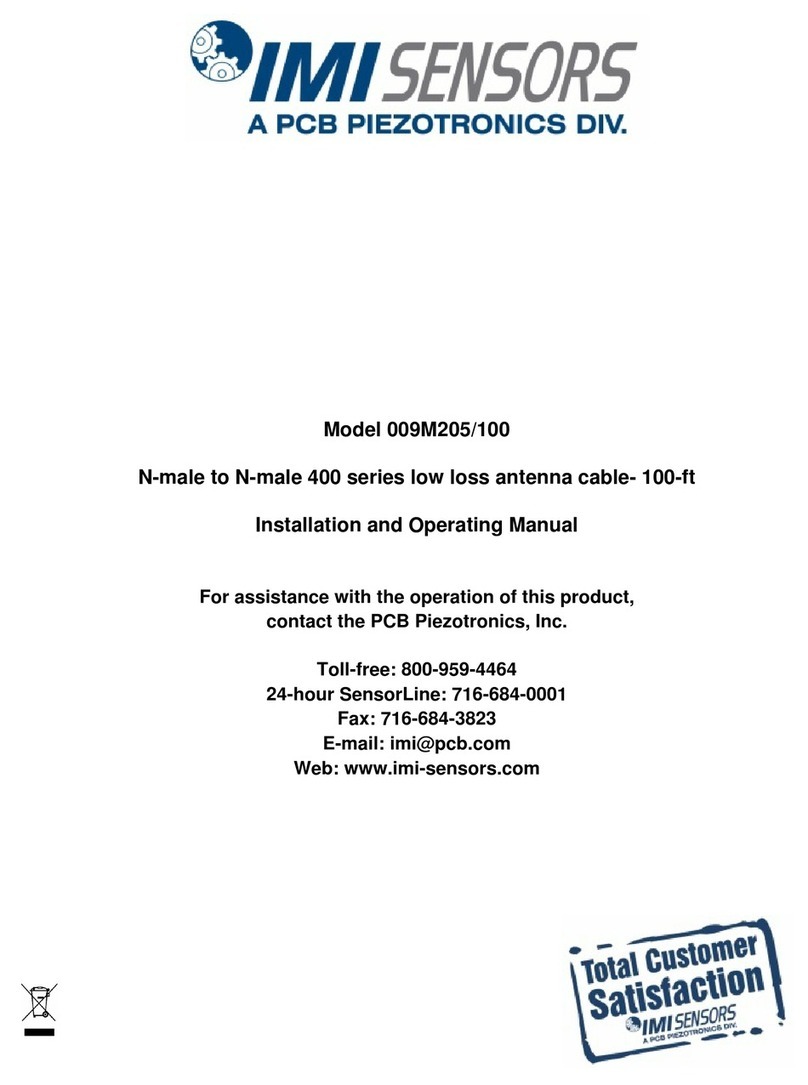
PCB Piezotronics
PCB Piezotronics IMI SENSORS 009M205/100 Installation and operating manual

NEUTRIK
NEUTRIK FIBERFOX EBC25 Handling instruction

Emerson
Emerson Rosemount 356 Reference manual
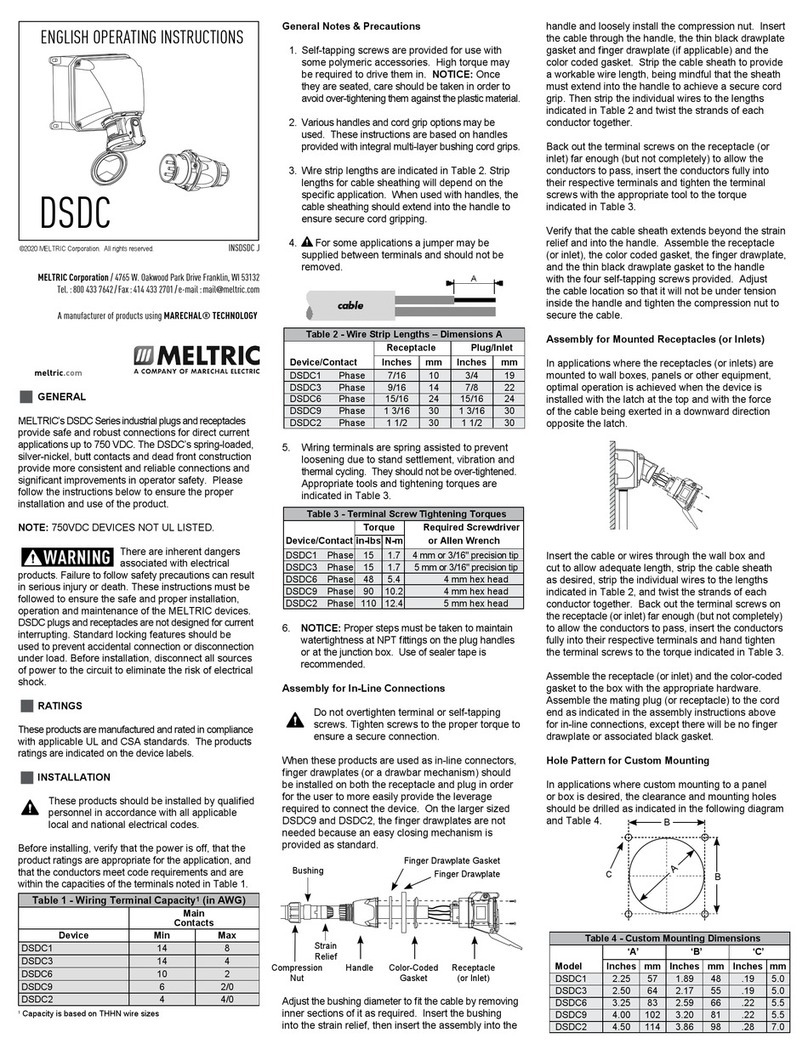
Meltric
Meltric DSDC Series operating instructions
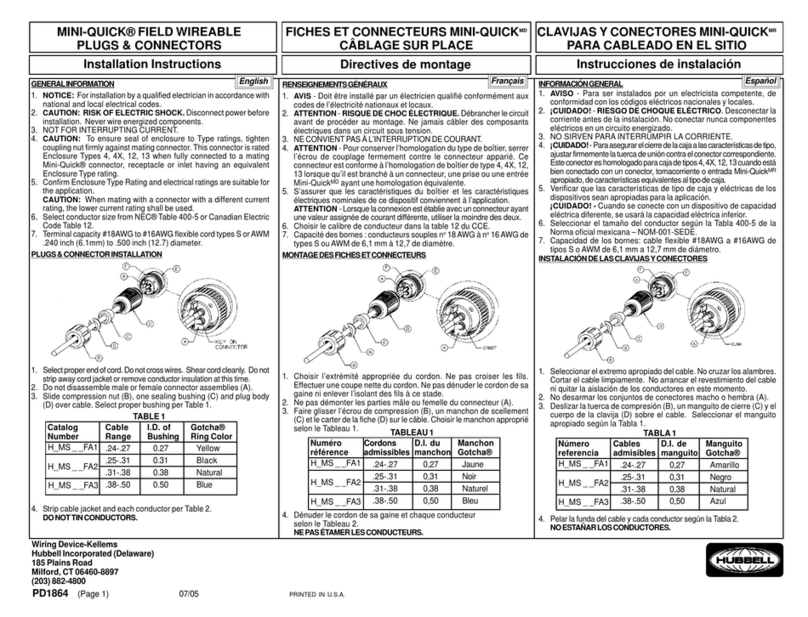
Hubbell
Hubbell MINI-QUICK H MS FA1 Series installation instructions

cable matters
cable matters Easy Transfer Cable user manual
